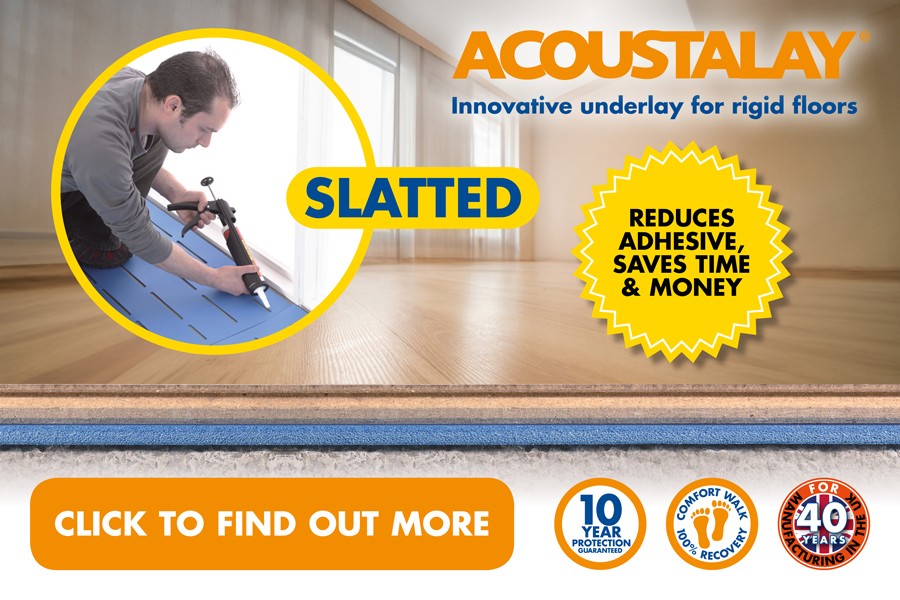Shared living spaces bring their own unique challenges, including a need to balance
durability and homely design. Richard Allen explains how LVT takes this in its stride
Communal living environments are rapidly evolving to meet the expectations of modern residents. Whether it’s a vibrant co-living community, dynamic student accommodation or a supportive retirement village, today’s shared residential spaces must be multi-functional, inclusive and homely.
As these environments grow more sophisticated so do the demands on interior finishes, especially flooring. In high-traffic, multi-use settings where comfort, durability, safety and design continuity all matter, LVT offers a uniquely balanced solution.
Flooring for multi-purpose spaces
Communal living spaces must support various activities, from quiet study and relaxation to group dining and socialising. Flooring can play more than a background role; it can help shape the way residents feel, move and interact.
In co-living and student accommodation, interiors must foster productivity, collaboration and downtime, often in the same open-plan layout. In retirement living, comfort, safety and emotional wellbeing are paramount. The common thread across all these environments is the need for resilient, adaptable surfaces that support a high-quality living experience for a broad range of users.
With an authentic look, design versatility, durability and low maintenance, LVT is the ideal choice for creating connected, purposeful zones without compromising on performance or aesthetic appeal.
Natural style that supports wellbeing
Today’s communal living designs aim to nurture personal wellbeing and community interaction, effortlessly encourage focus when needed while also enabling relaxation and spontaneous social exchange. LVT’s naturalistic wood and stone designs can be an ideal choice for calming tones and textures that are central to contemporary interiors that feel like home.
Combining aesthetic versatility with practical performance, some ranges can present a curated collection of soothing handcrafted designs with an authentic look of rare and exclusive woods and stones in calming earthy tones, making this a suitable fit for a welcoming biophilic style.
For example, a soothing warm oak design can effectively ground a shared study space, while a muted chalky stone design can create an inviting communal kitchen. In retirement living, these same neutral tones offer comfort and familiarity, contributing to an environment that not only restores wellbeing and fosters a sense of harmony, but also enhances mental clarity.
Defining purpose through design
One of LVT’s greatest strengths in these communal environments is its capacity to subtly define functional zones in shared spaces and open-plan layouts.
Interesting laying patterns can be used to establish intuitive spatial cues that help residents navigate and make sense of their environment. For example, a herringbone pattern can be used to identify a quiet seating zone while an adjoining straight lay or geometric pattern can highlight a walkway or dining area. Conveniently, ranges come with a consistent tile thickness allowing for the combination of wood and stone designs to create subtle visual continuity with complementary designs or spatial distinction using contrasting patterns.
This zoned approach is particularly beneficial in student and co-living settings where spaces need to be multifunctional: quiet in the morning, social in the evening, and adaptable at all times. Similarly, in retirement living, flooring patterns can be used to aid wayfinding and improve independence for residents with cognitive or mobility impairments.
Comfort, safety and accessibility
Shared living environments must cater to a diverse range of needs and abilities, particularly where accessibility and the safety of vulnerable individuals are key considerations.
LVT’s smooth surface makes it easier for people using wheelchairs or walking aids to move about independently while its slip-resistant properties reduce the risk of falls in high-traffic or wet areas.
Warm and soft compared to ceramic or stone, LVT is comfortable underfoot and also compatible with underfloor heating for additional comfort during the colder months, an important consideration for elderly residents and environments designed to promote wellness.
Moreover, with a hygienic surface that’s easy to maintain, this is the ideal choice for shared kitchens, lounges or entranceways where frequent cleaning is required. This contributes to lower maintenance costs and a healthier indoor environment that supports infection control and reduces allergens such as pollen or pet hair.
Performance that lasts
Communal living units are subject to intensive daily use so flooring must withstand everything from rolling furniture and dropped objects to spills and constant footfall. Engineered using the latest technology, LVT is designed to deliver this kind of robust performance without sacrificing style.
Some high quality LVT products offer stain resistance, dimensional stability and waterproof properties, making this the ideal choice for the most demanding situations such as kitchens, bathrooms and foyers.
This resilience is matched by design longevity. Neutral, nature-inspired designs are easy to live with and can adapt to evolving interior trends, making this a cost-effective investment for developments seeking a long-lasting solution with timeless appeal.
Creating a sense of home
Above all, residents in communal living environments want to feel at home. The challenge for designers is to create interiors that are warm, intuitive and uplifting while still meeting demanding technical specifications.
Combining aesthetic versatility with practicality, some LVT collections can present a curated range of soothing handcrafted designs with an authentic look of rare and exclusive natural woods and stones in calming earthy tones, making this the perfect fit for contemporary biophilic style without the restrictive cost and ongoing maintenance of natural materials.
A practical and design-led solution
All shared spaces need flooring that’s as versatile as the people who use them. LVT offers a unique combination of technical performance, aesthetic beauty and design flexibility, making it ideally suited to the challenges of communal residential environments.
Regarding LVT, specifiers can confidently create interiors that feel cohesive, comforting and built to last, supporting not just the functionality of shared living but also the wellbeing of those who call these spaces home.
www.karndean.com
Richard Allen is commercial sales director at Karndean Designflooring


